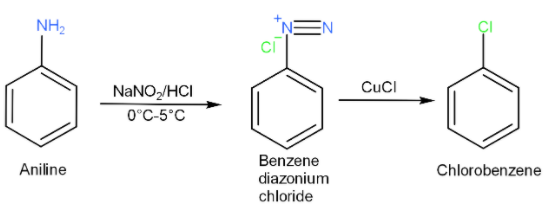
Chlorobenzene can be prepared by reacting aniline with:
(A) Hydrochloric acid (HCl)
(B) Cuprous chloride $\left( C{{u}_{2}}C{{l}_{2}} \right)$
(C) Chlorine in the presence of anhydrous aluminium chloride
(D) Nitrous acid followed by heating with cuprous chloride (CuCl)
Answer
121.5k+ views
Hint: Start by drawing the structure of the reactant. Think what kind of reactions aniline undergoes with the given reagents in the options. The product formed should not contain any other substituent on the ring except chlorine.
Complete step by step solution:
-Aniline is an aromatic amine. It is a base.
-Let’s have a look at the question. We need to prepare chlorobenzene from aniline. That means the amine group needs to be replaced by a chlorine group.
-We have studies that amine group can only be replaced after it has been converted to diazonium salt form, which is unstable. Direct halogenation of aniline will give rise to halogen derivatives of aniline.
-If HCl is added to aniline, then aniline being a base will abstract the proton and form anilinium chloride salt.
-When aniline is treated with nitrous acid, which is produced in situ by sodium nitrite and hydrochloric acid, at low temperature $\left( 0{}^\circ C-5{}^\circ C \right)$, then aniline is converted to a benzene diazonium salt. This reaction is known as diazotization.

-When a freshly prepared solution of benzene diazonium salt is treated with cuprous chloride (CuCl), it gives chlorobenzene. This reaction is known as Sandmeyer’s reaction.
-Therefore, chlorobenzene can be prepared by reacting aniline with nitrous acid followed by heating with cuprous chloride (CuCl).
Therefore, the correct option is (D).
Note: Chlorobenzene can also be prepared by treating benzene diazonium salt with copper powder and hydrochloric acid. This reaction is known as Gattermann reaction and has a better yield than Sandmeyer reaction. Remember in aromatic compounds electrophilic substitution reactions occur readily and therefore, direct halogenation will yield halo-substituted compounds.
Complete step by step solution:
-Aniline is an aromatic amine. It is a base.
-Let’s have a look at the question. We need to prepare chlorobenzene from aniline. That means the amine group needs to be replaced by a chlorine group.
-We have studies that amine group can only be replaced after it has been converted to diazonium salt form, which is unstable. Direct halogenation of aniline will give rise to halogen derivatives of aniline.
-If HCl is added to aniline, then aniline being a base will abstract the proton and form anilinium chloride salt.
-When aniline is treated with nitrous acid, which is produced in situ by sodium nitrite and hydrochloric acid, at low temperature $\left( 0{}^\circ C-5{}^\circ C \right)$, then aniline is converted to a benzene diazonium salt. This reaction is known as diazotization.

-When a freshly prepared solution of benzene diazonium salt is treated with cuprous chloride (CuCl), it gives chlorobenzene. This reaction is known as Sandmeyer’s reaction.
-Therefore, chlorobenzene can be prepared by reacting aniline with nitrous acid followed by heating with cuprous chloride (CuCl).
Therefore, the correct option is (D).
Note: Chlorobenzene can also be prepared by treating benzene diazonium salt with copper powder and hydrochloric acid. This reaction is known as Gattermann reaction and has a better yield than Sandmeyer reaction. Remember in aromatic compounds electrophilic substitution reactions occur readily and therefore, direct halogenation will yield halo-substituted compounds.
Recently Updated Pages
Classification of Drugs Based on Pharmacological Effect, Drug Action

Types of Solutions - Solution in Chemistry

Difference Between Alcohol and Phenol

JEE Main Participating Colleges 2024 - A Complete List of Top Colleges

JEE Main Maths Paper Pattern 2025 – Marking, Sections & Tips

Sign up for JEE Main 2025 Live Classes - Vedantu

Trending doubts
JEE Mains 2025: Check Important Dates, Syllabus, Exam Pattern, Fee and Updates

JEE Main Login 2045: Step-by-Step Instructions and Details

JEE Main Chemistry Question Paper with Answer Keys and Solutions

JEE Main Exam Marking Scheme: Detailed Breakdown of Marks and Negative Marking

JEE Main 2023 January 24 Shift 2 Question Paper with Answer Keys & Solutions

JEE Main Chemistry Online Mock Test for Class 12

Other Pages
NCERT Solutions for Class 12 Chemistry Chapter 6 Haloalkanes and Haloarenes

NCERT Solutions for Class 12 Chemistry Chapter 1 Solutions

NCERT Solutions for Class 12 Chemistry Chapter 2 Electrochemistry

JEE Advanced Marks vs Ranks 2025: Understanding Category-wise Qualifying Marks and Previous Year Cut-offs

NCERT Solutions for Class 12 Chemistry Chapter 7 Alcohol Phenol and Ether

NCERT Solutions for Class 12 Chemistry Chapter 8 Aldehydes Ketones and Carboxylic Acids




